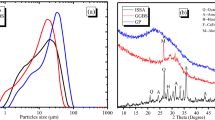Abstract
Partially laterised khondalite rocks are the mining waste generated during the mining of bauxite for the production of aluminium. These wastes create environmental pollution as these are dumped at the mining area in huge amounts. An attempt has been made to recover the valuable material from this mining waste which are environmental friendly. The samples were collected, and a composite sample was prepared for size reduction and classification using unit operations. The finely sized material from hydrocyclone overflow was subjected to bioleaching using different microorganisms, especially bacteria. There are two types of bacterial culture methods that are selected based on the agent being cultured and the downstream use. The methods are solid media (Agar plates) and liquid media (Broth cultures). The analysis of the sample for both iron and alumina was taken by chemical method for 2 days, 4 days, 7 days, and 10 days. It is observed that the iron percentage reduced by 36.98% and alumina reduced by 38.40% by culturing the sample with microorganisms. The coloured bricks were prepared from the product and tested. The product has also been compared with standard that indicates its suitability for coloured brick preparation.







Similar content being viewed by others
References
K. Bosecker, Bioleaching: metal solubilisation by microorganisms. FEMS Microbiol. Rev. 20(3–4), 591–604 (1997)
Y. Ghorbani, M. Oliazadeh, A.R. Roohi, A. Pirayehgar, Use of some isolated fungi in biological leaching of aluminium from low grade bauxite. Afr. J. Biotechnol. 6(11), 1284–1288 (2007)
M.R. Hosseini, M. Pazouki, M. Ranjbar, M. Habibian, Bioleaching of iron from highly contaminated Kaolin clay by Aspergillus niger. Appl. Clay Sci. 37, 251–257 (2007)
M. Ranjbar, E. Aghaie, M.R. Hosseini, M. Pazouki, F. Ghavipanjeh, Optimisattion of kaolin bioleaching by Aspergillus niger. Adv. Mater. Res. 20–21, 115–118 (2007)
R. Swain, R. Bhima Rao, Recovery of graphite values from carboniferous kaolinite clay of Easternghats for use in refractory applications. World Metall Erzmetall 65(4), 239 (2012)
R. Swain, R. BhimaRao, Kinetic study on leaching of iron in partially laterised khondalite rocks for ceramic industrial applications. Int. J. Miner. Process. 112113, 77–83 (2012)
R.C. Dubey, D.K. Maheswari, Practical Microbiology. S. Chand Company Ltd., New Delhi (An ISO 9001:2008 Company)
Funding
No funding is from any outside source.
Author information
Authors and Affiliations
Corresponding author
Ethics declarations
Conflict of interest
There is no conflict of interest.
Additional information
Publisher's Note
Springer Nature remains neutral with regard to jurisdictional claims in published maps and institutional affiliations.
Rights and permissions
About this article
Cite this article
Swain, R., Routray, S., Mohapatro, R.N. et al. Application of Bioleaching to Recover Value-Added Product from partially Laterised Khondalite Rocks: A Bauxite Mining Waste. J. Inst. Eng. India Ser. D 103, 57–62 (2022). https://doi.org/10.1007/s40033-021-00323-9
Received:
Accepted:
Published:
Issue Date:
DOI: https://doi.org/10.1007/s40033-021-00323-9




